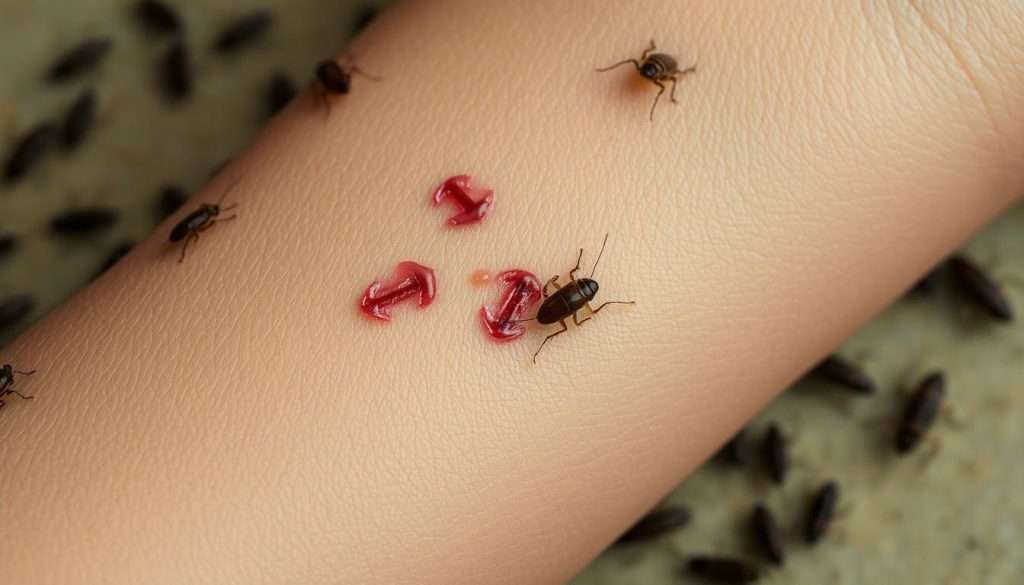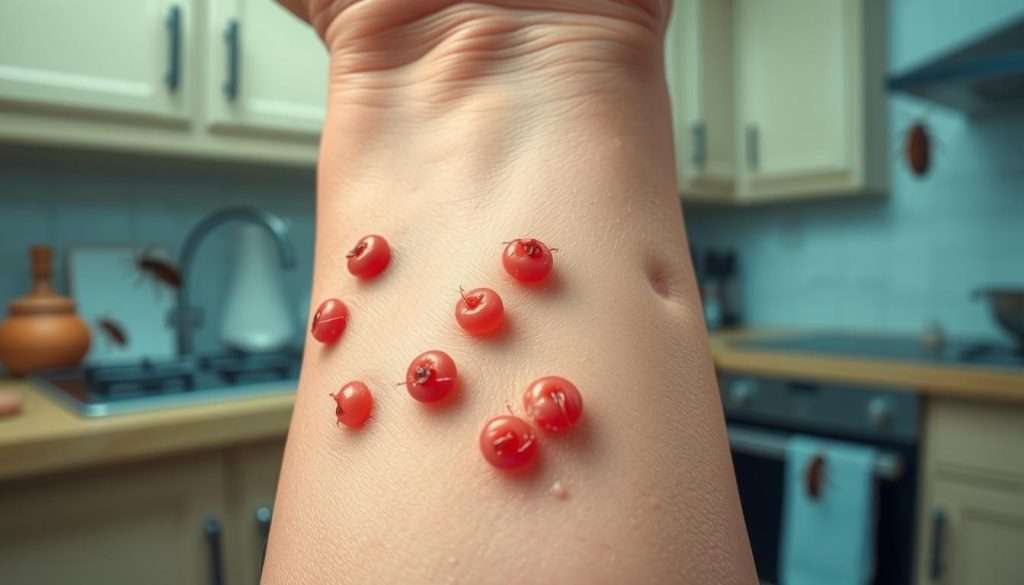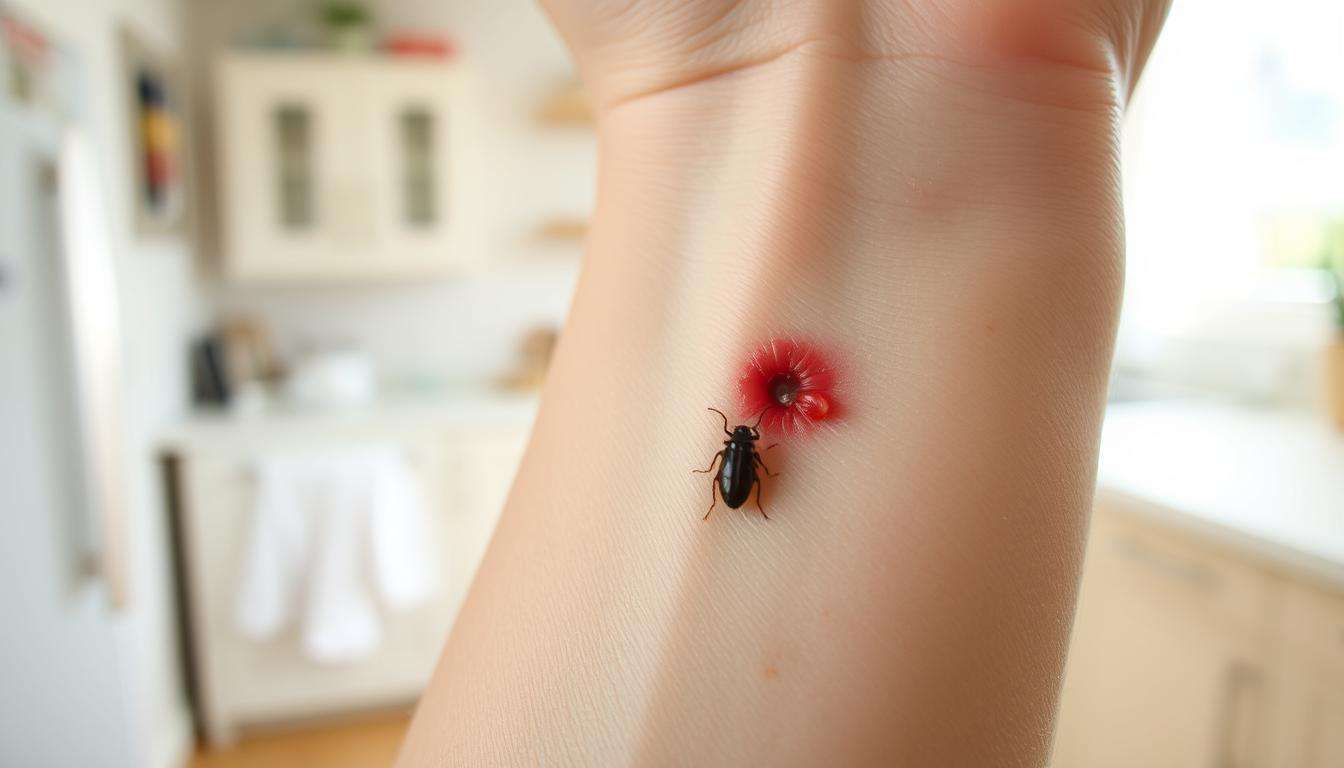Cockroach bites are rare but can happen when food is scarce. Knowing what a cockroach bite looks like is key. These pests bite at night when humans are asleep.
Spotting cockroach bite symptoms helps you tell them apart from other insect bites. This ensures you get the right treatment and take steps to prevent more bites.
Key Takeaways
- Cockroach bites are rare and typically occur during food shortages.
- Bites usually appear as bright red raised bumps, about 1-4 mm wide.
- Common areas for bites include hands, feet, and eyelashes.
- While they do not transmit diseases, cockroach bites can cause irritation and allergic reactions.
- Maintaining cleanliness can help prevent roach infestations and reduce bite risks.
- Severe allergic reactions, although rare, may require immediate medical attention.
Understanding Cockroach Behavior and Biting
Cockroaches are fascinating insects known for their resilience and adaptability. Their cockroach behavior is key to understanding infestations. These nocturnal pests like warm, moist places to find food scraps and organic matter. They look for grease, paper, and crumbs, especially at night.
While cockroach bites are rare, they can happen in bad infestations or when food is hard to find. Cockroaches usually run away from humans. They don’t see humans as food, and bites are mostly when they feel scared. Knowing about cockroach biting habits can lower the chance of bites.
Most people get minor skin irritation from cockroach bites, not serious health problems. Bites are more common in dirty places, especially around kids. They look like small red bumps, like other insect bites. Keeping things clean and sealing entry points helps keep these pests away. For more info on cockroach behavior and bite risks, check here.
| Aspect | Details |
|---|---|
| Feeding Habits | Scavenge for food crumbs and decaying matter |
| Bite Behavior | Rarely bite; usually defensive rather than predatory |
| Environmental Influence | Higher likelihood of bites in neglected, unclean environments |
| Health Risks | Minor irritation possible; risk of infection if bites become infected |
| Preventive Measures | Maintain cleanliness; seal entry points |
Do Cockroaches Bite Humans?
Cockroaches rarely bite humans, but it can happen. They might bite when they can’t find food. They like to eat food scraps or dead skin cells, especially around nails or mouths.
Human bites from cockroaches are not common. But, they can cause small, red spots and infections. The bites look like bright red, itchy bumps, bigger than mosquito bites. They can make your skin itch, swell, and turn red.
Cockroaches usually don’t want to bite humans. They only do so when they have to. Poor cleaning and leaving food out can make them bite.
To stop cockroaches from biting, keep your home clean. Here’s how:
- Regular cleaning to get rid of food scraps
- Sealing gaps and cracks in your home
- Using affordable baits and traps from stores
These steps can help avoid cockroach bites. Even though bites are rare, controlling pests is key to a healthy home.

What Does a Cockroach Bite Look Like
Cockroach bites are not common, but knowing what they look like is key. Spotting them early helps tackle pest problems fast. Seeing their look is crucial to tell them apart from other bug bites.
Visual Characteristics of Cockroach Bites
Cockroach bites are bright red and raised, about 1 to 4 mm wide. They look like single bumps, not clusters like bed bug bites. Their patterns are not as clear as mosquito bites, making them harder to spot.
In severe cases, bites can turn into patches or even abrasions. This can cause more inflammation, especially in sensitive spots like the mouth or around fingernails.
Comparison with Bites from Other Insects
Cockroach bites differ from those of mosquitoes or fleas. The table below shows how cockroach bites compare with bites from other common insects:
| Insect Type | Appearance | Location of Bites | Possible Reaction |
|---|---|---|---|
| Cockroach | Bright red, raised bumps | Specific areas with food residue (mouth, nails) | Inflammation, itching, lesions |
| Mosquito | Swollen, itchy welts | Random body areas | Itching, swelling |
| Flea | Small, red dottish bumps | Lower leg and ankle areas | Intense itching, rash |
| Bed Bug | Red, inflamed clusters | Exposed skin areas during sleep | Severe itching, possible allergic reactions |
Knowing what cockroach bites look like helps in identifying them. It also shows why keeping your place clean is important. If you think you have a cockroach problem, call Lake Norman Home Services for help.
Signs & Symptoms of Cockroach Bites
It’s important to know the signs of cockroach bites. These bites are not common, but knowing the signs can help you act fast. When a cockroach bites, you might see different signs.
Physical Reactions to Bites
After a cockroach bite, you might notice:
- Swelling: The area can swell quickly, causing pain.
- Redness: The skin might turn red and inflamed.
- Bumps: You could see raised red bumps that are not even.
- Rashes: A rash can appear as a reaction to the bite.
These signs can last for days, sometimes up to a week, depending on how sensitive you are.
Potential Allergic Reactions
Some people can have serious allergic reactions to cockroach bites. The proteins in their saliva can cause:
- Extreme swelling
- Intense itching
- Skin rashes that can spread beyond the bite site
- In rare cases, anaphylactic reactions—resulting in shortness of breath, low blood pressure, or shock
If you have severe symptoms, get medical help right away.
Common Areas of Bites
Cockroach bites often happen in certain areas, especially when you’re sleeping. These areas include:
- Face (especially eyelashes)
- Mouth
- Hands and fingers (including fingernails)

What Happens When a Cockroach Bites You?
When a cockroach bites you, it can cause irritation, swelling, and itching. These bites look like small, itchy, bright red bumps. They might be a bit bigger than mosquito bites.
Even though cockroach bites are not dangerous, they can lead to problems. Scratching the bite too much can cause infections. This is because cockroaches carry bacteria from their dirty habits.
Cockroaches rarely bite people, but they might when they find food. They like to bite the face, mouth, hands, and fingers. The main worry is not just the bite. It’s also the risk of getting sick from their bacteria, like Salmonella and E. coli.
If you have severe swelling, intense itching, or signs of infection, see a doctor. Keeping your place clean and using pest control can help avoid bites.
| Symptom | Description |
|---|---|
| Itching | Commonly accompanies bites, leading to discomfort. |
| Red Bumps | Appearance similar to mosquito bites, but usually larger. |
| Swelling | Localized areas around the bite may swell, increasing irritation. |
| Potential Infection | Scratching bites can lead to secondary infections. |
Cockroach Bite Treatment Options
Treating a cockroach bite right away is key to avoid discomfort and infection. Bites are rare, but quick action helps manage symptoms like redness, itching, and swelling.
Home Remedies for Relief
Home remedies can help with cockroach bite relief. First, clean the area with warm, soapy water to lower infection risk. Here are some remedies:
- Ice packs on the bite can lessen swelling.
- Aloe vera gel soothes irritated skin.
- Calamine lotion eases itching and discomfort.
- Tea bags or lemon juice may reduce inflammation.
Over-the-Counter Solutions
For severe symptoms, over-the-counter treatments can help with cockroach bite treatment. These include:
- Antihistamines for itching from a cockroach bite allergy.
- Hydrocortisone cream to reduce inflammation.
- Oral pain relievers for discomfort.
If symptoms worsen, like intense pain or swelling, see a doctor fast. They can give the right treatment and care for severe reactions or infections.
Preventing Cockroach Bites
To stop cockroach bites, keep your place clean and tidy. Cockroaches love dirty spots. So, start by:
- Regularly cleaning surfaces to remove food debris.
- Properly sealing cracks and crevices to eliminate entry points.
- Ensuring trash is disposed of securely and regularly.
Using good cockroach control can help a lot. Cockroaches usually don’t bite humans unless they’re really hungry. Here’s how to keep them away:
- Using traps and baits to monitor and control their population.
- Employing professional pest control services for severe infestations.
- Adopting personal hygiene practices to limit attractants in your home.
Conclusion
Knowing what a cockroach bite looks like is key. It helps you spot and treat bites quickly. Even though bites are rare, they show a bigger problem at home.
These bites look like mosquito bites and are red and raised. They happen when places get too crowded or food runs out.
To keep your home clean and safe, fight cockroach bites with prevention. Regular checks and professional help are vital. They stop infestations and health risks from cockroaches.
Act fast if you see signs of bites. This keeps your home healthy for everyone. It also stops bites and keeps you comfortable.
If you see signs of cockroach bites, get help from a pest control expert. They will make sure your home is safe and free from cockroaches.
